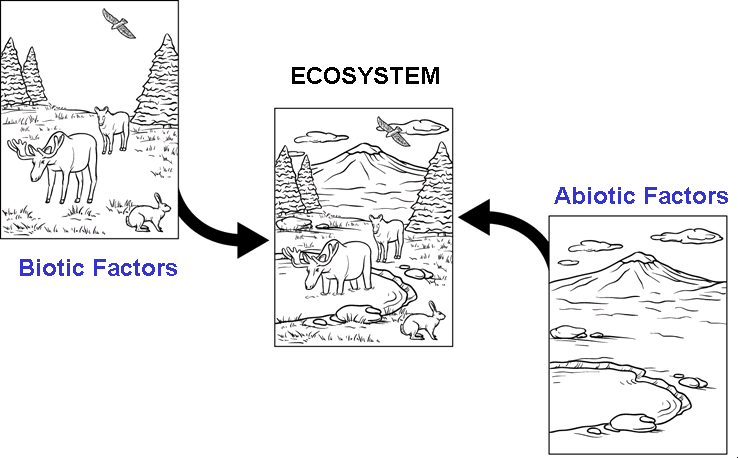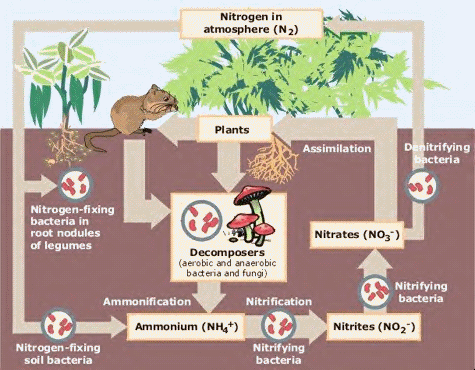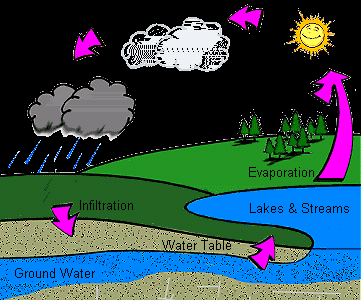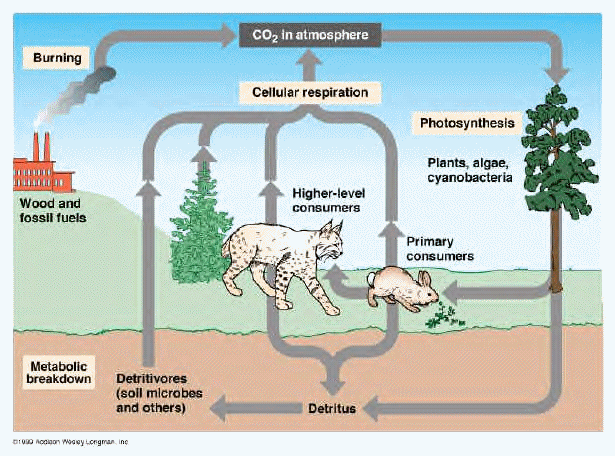 Ecology:
the study of interactions of organisms and their physical
environment.
Ecology:
the study of interactions of organisms and their physical
environment. Ecology:
the study of interactions of organisms and their physical
environment.
Ecology:
the study of interactions of organisms and their physical
environment.
Community: organisms that live in a particular place.
Biotic factors: living factors affecting an environment.
Habitat: physical location of community.
Abiotic factors: nonliving parts of the environment, such as climate and light.
Ecosystem: self-sustaining collection of organisms and their physical environments.

Diversity of ecosystem: measure of number of species living in ecosystem and how common each species is.
Stability: the ability of an ecosystem to resist change in the face of disturbances.
Carrying Capacity: the number of one species that an environment can support.
Limiting factor: any biotic or abiotic factor that restricts the existance, numbers, or reproduction of a population
Density-dependent factors: have an increasing effect as the populations increasesDensity-independent factors: affect all populations, regardless of their density.
Energy in ecosystems
Producers: take in energy, store in complex molecules. include plants, algae, and some bacteria.
Consumers: all other organisms which obtain energy by consuming other organisms.
Decomposers: special consumers that obtain energy by consuming organic wastes, dead bodies. includes fungi and some bacteria.
Energy flow
Trophic Levels: a group of organisms whose energy sources are the same number of steps away from the sun.
1st trophic level: producers (autotrophs).
2nd trophic level: animals that eat plants (herbivores). primary consumers.
3rd trophic level: animals that eat herbivores (carnivores). secondary consumers.
4th trophic level: animals that feed on carnivores. tertiary consumers. all ecosystems must contain decomposers (detritivores)!!
Food Web: a complex network of feeding relationships in an ecosystem.
Food chain: Path of energy through trophic levels. arrows follow the path of energy.
Interactions within ecosystems
Niche: sum of organism's interactions with its physical environment and with other organisms.
Coevolution: two or more species evolve in response to each other.
Predation: one organism feeds on another.
Symbiosis: close long-term relationship between two or more species.
1. Parasitism: obtain nutrients by feeding on living host, usually harming but not killing it. example: tapeworm and host.2. Mutualism: both participants benefit. example: lichen; plants and their pollinators.
3. Commensalism: one species benefits, the other is unaffected. example: remora and shark
Competition: the use or defense of a resource by one individual that reduces the availability of that resource to other individuals.
1. intraspecific competition: between members of the same species.2. interspecific competition: between different species.
Nutrient cycles
Nitrogen Cycle: nitrogen is necessary to make proteins and nucleic acids.
1. nitrogen fixation by bacteria breaks bonds and allows nitrogen atoms to react with hydrogen atoms to form ammonia.2. assimilation: plants absorb ammonia and incorporate it into their compounds.
3. ammonification: nitrogen returns to soil.
5. denitrification: conversion of nitrate to nitrogen gas.

Water Cycle
1. Non-living cycle: water vapor in atmosphere condenses, falls to the earth's surface as precipitation. seeps into soil and becomes ground water. remaining water is heated by the sun to reenter the atmosphere by evaporation.2. Living cycle: taken up by plant roots, moves into the atmosphere by transpiration Carbon Cycle: carbon dioxide in air is used by plants during photosynthesis. consumers break down carbon compounds by cellular respiration, and release carbon dioxide into the atmosphere as carbon dioxide.

Carbon Cycle:
carbon dioxide in air is used by plants during photosynthesis. consumers obtain carbon compounds from plants, break them down by cellular respiration, and release carbon dioxide into the atmosphere

Phosphorous Cycle: phosphorus is needed in ATP and DNA. usually found in soil and rocks, which dissolves in water to form phosphate ions. phosphorus can lead to algal blooms which kills other organisms in the lake when bacteria, which feed on the dead algae, use up dissolved oxygen in the water.
Succession: gradual sequential replacement of populations in an area.
Primary succession: occurs in areas where nothing has ever grown before. Creates new colonies of organisms in new areas where no soil exists. Soil must be made by breaking down rocks.
Pioneer species: the first to colonize a new habitat.
Seral community: each of the intermediate communities that arise through the process of succession.
Climax community: one that will remain stable as long as the area is undisturbed.
Secondary succession: areas where there has been previous growth. habitats were disturbed, but not totally stripped of vegetation and soil.
Succession in lakes: lakes that change from crystal clear bodies of water to dry land when the lake becomes filled in with sediment.
Eutrophication: process of adding large amounts of nutrients to the water.
Biome: large geographic area of similar climate and life forms.
Aquatic biomes
a. Water
b. Estuary - mix of salt and fresh waters
c. Photic zones - areas of water shallow enough for light to penetrate
d. Aphotic zones - deep areas of water with no light available
Marineabiotic: salt water, distribution of life dependent on water temperature and lightbiotic: plankton, starfish, whales, sharks, squid, rays, large fish
Freshwater
abiotic: lakes, ponds, rivers, streams, brooks, contain little salt, life distribution is dependent on dissolved oxygen contentbiotic: algae, catfish, carp, bass, lake trout, mosses, flowering lilies, frogs
Terrestrial biomes: land areas that exhibit many types of climates, land forms, and species
Tundraabiotic factors: cold temperatures, long severe winters, permafrostbiotic factors: lichens, mosses, small plants, polar bears, musk ox, reindeer, caribou, lemmings, arctic foxes, arctic hares
Taiga (Boreal Forests)
abiotic factors: summers short and warm, winters long, snowy, cold has most spongy areas called bogsbiotic factors: evergreen trees, moose, bears, lynxes, elk, wolves, porcupines, wolverines, hares, bobcats
Deciduous forests
abiotic: rainfall: 60-100 cm, winters long and severebiotic: trees that lose their leaves in fall: maples, beeches, elms, oaks, basswoods, shrubs, varied animal life: mice, squirrels, foxes, bears, wildcats, salamanders, snakes, lizards, rabbits, chipmunks
Grasslands
abiotic: rainfall: 10-60 cm, central part of U.S., warm spring, scorching dry seasons, winters can be snowybiotic: grasses: wheat, oats, barley, corn, bison, antelope, prairie dogs, coyotes, badgers
Savannah: special type of grassland; warm all year. animals: zebra, antelopes, gazelles, elephants, wildebeest, , giraffes
Tropical rain forest
abiotic: rainfall may be over 500 cm, warm temperaturebiotic: vines, ferns, large flowering trees, insects, birds, monkeys, snakes, lizards, jaguars, panthers
Deserts
abiotic: sandy, rainfall: less than 20 cm ,hot, dry regionsbiotic: cacti, mesquite, insects, birds, iguanas, gila monsters, horned lizards, kangaroo rats, scorpions, spiders, snakes